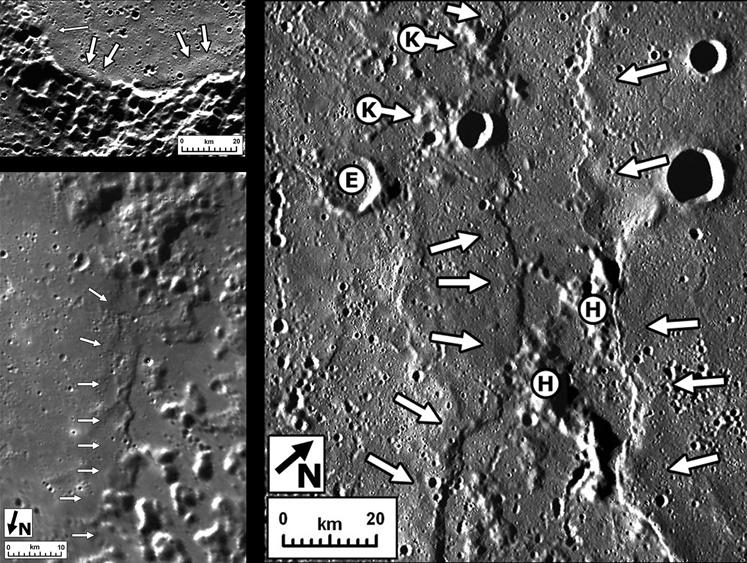
WIKIARCHIVES.SPACE
The Human Spaceflight Archive

Features interpreted to be lava flow fronts associated with the northern smooth plains deposits on Mercury. (Upper left) Steep flow margin within a flooded impact crater (thick arrows); narrow arrow points to possible flooding of a smaller crater. (Lower left) Smooth plains (left) embaying rough plains (right), with flow front indicated by arrows. (Right) Candidate lava flow fronts (arrows) facing each other. The western flow unit is embaying a crater (E) and flooding the hills (H) between flow fronts to form kipukas (K), islands of pre-existing terrain flooded by lava.
Information
- Taken in
- Author
- Courtesy AAAS/Science
- Description
-
Features interpreted to be lava flow fronts associated with the northern smooth plains deposits on Mercury. (Upper left) Steep flow margin within a flooded impact crater (thick arrows); narrow arrow points to possible flooding of a smaller crater. (Lower left) Smooth plains (left) embaying rough plains (right), with flow front indicated by arrows. (Right) Candidate lava flow fronts (arrows) facing each other. The western flow unit is embaying a crater (E) and flooding the hills (H) between flow fronts to form kipukas (K), islands of pre-existing terrain flooded by lava.
The MESSENGER spacecraft is the first ever to orbit the planet Mercury, and the spacecraft's seven scientific instruments and radio science investigation are unraveling the history and evolution of the Solar System's innermost planet. Visit the Why Mercury? section of this website to learn more about the key science questions that the MESSENGER mission is addressing. During the one-year primary mission, MDIS is scheduled to acquire more than 75,000 images in support of MESSENGER's science goals.
Date Presented: September 29, 2011, at a NASA Press Briefing
Instrument: Mercury Dual Imaging System (MDIS)
- Created on
- Thursday 29 September 2011
- Albums
- US SPACE PROGRAM / PROBES / MERCURY / MESSENGER / Annoted/Science
- Source link
- https://photojournal.jpl.nasa.gov
- Visits
- 19
- Rating score
- no rate
- Rate this photo
- License
- Public Domain
- Modified by WikiArchives
- No (original)
- Downloads
- 0
Powered by Piwigo












